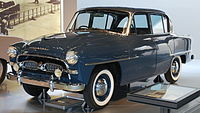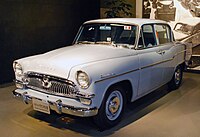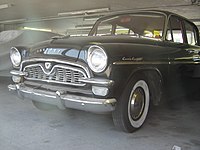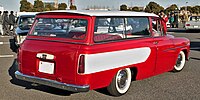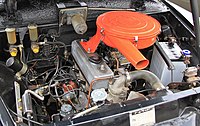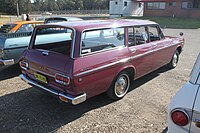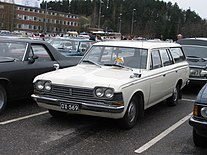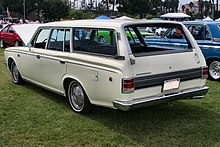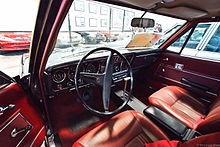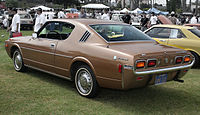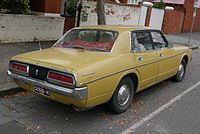
A | B | C | D | E | F | G | H | CH | I | J | K | L | M | N | O | P | Q | R | S | T | U | V | W | X | Y | Z | 0 | 1 | 2 | 3 | 4 | 5 | 6 | 7 | 8 | 9
| Toyota Crown | |
|---|---|
 2018–2019 Toyota Crown 3.5 Hybrid RS Advance (GWS224, Japan) | |
| Overview | |
| Manufacturer | Toyota |
| Production | 1955–present |
| Assembly |
|
| Body and chassis | |
| Class | Mid-size luxury car (E) |
| Body style |
|
| Layout |
|
| Related |
|
| Chronology | |
| Successor |
|
The Toyota Crown (Japanese: トヨタ・クラウン, Hepburn: Toyota Kuraun) is an automobile which has been produced by Toyota in Japan since 1955. It is primarily a line of mid-size luxury cars that is marketed as an upmarket offering in the Toyota lineup.
In North America, the first through fourth generations were offered from 1958 through 1972, being replaced by the Corona Mark II.[2] The Crown nameplate returned to the North American market in 2022, when the sixteenth-generation model was released. The Crown has also been partially succeeded in export markets by its closely related sibling, the Lexus GS, which since its debut in 1991 as the Toyota Aristo has always shared the Crown's platform and powertrain options. Later models of the GS and Crown have taken on a very strong aesthetic kinship through shared design cues.
In 2022, Toyota unveiled four different Crown models to replace the fifteenth-generation model. The first model that is available is the Crossover-type Crown, which is also marketed in North America as the sole Crown model. The remaining three models: Sedan, Sport, and Estate, will be released in 2023 and 2024 respectively, and will be available in hybrid, plug-in hybrid, and fuel cell powertrains depending on the model.
The Crown's history and reputation has given it prominence in the Toyota lineup, as it is one of the few current Toyota models to carry its own unique insignia for the model line with the current Crown having a stylized crown emblem on the grill and steering wheel along with inspiring the names of its smaller progenitors. The Corona, introduced as a smaller companion to the Crown means "crown" in Latin and was initially exported as the "Tiara", while the Corolla took its name from the corolla ("small crown") in Latin. The Camry's name is derived from the Japanese phrase kanmuri (冠, かんむり) meaning "little crown" and the Scepter took its name from the sceptre, an accessory to a crown. The Avalon (the Crown's North American counterpart), while not named after a crown, is named after a mythical island from the legends of King Arthur. In 1980, the Toyota Cresta was introduced to Japan only, and was based on the Toyota Mark II. 'Cresta' is Latin for a decorative, ceremonial feature added to the top of a helmet.
History

Introduced in 1955 as the Toyopet Crown, it has served as the mainstream sedan from Toyota in the Japanese market throughout its existence and holds the distinction of being the longest-running passenger-car nameplate affixed to any Toyota model. Its traditional competitors in Japan and Asia were the defunct Nissan Cedric/Gloria/Fuga, Honda Legend, Mazda Luce, Isuzu Bellel and Mitsubishi Debonair.
Formerly only available at Toyota Store dealers in Japan, the Crown has been popular for government usage, whether as a police car or for transporting government officials. It has also been popular with Japanese companies as company cars along with use as a taxicab. While a base Crown was available for many years aimed at the taxicab market, the increasing opulence and price of the Crown line led to the creation of the Comfort in 1995 as a more affordable alternative. Outside Japan, the larger Lexus LS took over the role of Toyota's flagship sedan in 1989 in the company's global lineup.
Toyota's "Discover Crown Spirit Project" is a program in which Japanese Toyota dealers fully restore instances of every generation of the Crown to show that even the oldest Crown still works.[3]
Having been in production since 1955, the Crown is the second longest running model nameplate in Japan after the Land Cruiser, and seventh in the world after the Mercedes-Benz S-Class (1954), Chevrolet Corvette (1953), Toyota Land Cruiser (1951), Volkswagen Transporter (1950), Ford F-Series (1947), and Chevrolet Suburban (1935).
Exports
The Crown was first exported to the United States from 1958 to 1973 as the first model Toyota exported to the country.[2] In 1960, Toyota temporarily suspended exports to the region as the Crown was not capable of speeds needed on American freeways, before introducing an improved model.[4] The Crown was also exported to Canada from 1964 to 1972, and Mexico from 1959 to 1964.[5][6]
Exports to Europe began in 1964 with the first cars going to Finland. Other European countries which saw early imports of the Crown included the Netherlands and Belgium. The United Kingdom was another European market until the early 1980s. Australia was another important export market for the Crown – to the extent that it was manufactured there from the mid-1960s until the late 1980s using many local components. It was discontinued when the button car plan was put into effect.[citation needed]
Exports to New Zealand began in 1968 and local CKD kit assembly of the Deluxe sedan started in 1973 (under contract at Steel's Motor Assemblies in Christchurch alongside the Corona). The model was replaced in NZ assembly by the Cressida in 1979 though limited imports of Japanese assembled cars continued for several more years.[citation needed]
The island nations of Aruba and Curaçao in the Southern Caribbean also imported the Crown starting from the second generation (S40) in 1965 in Curaçao up until importation of the tenth generation (S150). It was discontinued in 1998 due to the high price and low demand combined with the introduction of the Lexus GS series.[citation needed]
In 2019, a small number of fifteenth-generation Crowns were exported to Indonesia for use as an official vehicle by cabinet ministers and other government officials.[7]
The sixteenth-generation Crown that was introduced in 2022 will be exported to about 40 countries with an expected annual sales volume of around 200,000 units.[8]
In September 2023, Toyota said that a new, larger plug-in hybrid version of the Century would be offered for sale to customers in all regions of the world.[9]
Toyopet Crown – First generation (RS/S10/S20/S30; 1955)
| Toyopet Crown – First generation | |
|---|---|
 | |
| Overview | |
| Model code |
|
| Also called | Toyopet Masterline (commercial models) |
| Production | January 1955–1962 |
| Designer | Kenya Nakamura |
| Body and chassis | |
| Body style |
|
| Layout | Front-engine, rear-wheel-drive |
| Related | |
| Powertrain | |
| Engine | |
| Dimensions | |
| Wheelbase | 2,530 mm (99.6 in) |
| Length | 4,285 mm (168.7 in) |
| Width | 1,679 mm (66.1 in) |
| Height | 1,524 mm (60.0 in) |
| Curb weight | 1,152–1,216 kg (2,540–2,681 lb) |
The Crown was introduced in January 1955 in Japan to meet the demands of public transportation.[10][11] The Crown was intended for private purchase, while the Master served in a commercial form as a taxi, both with the same 1.5 L Type R engine used on their previous car, the Toyopet Super. The front doors open conventionally, and the rear doors are "suicide doors", a feature also utilized on the Toyota AA, Toyota's first car. Small engine displacements were used to keep the vehicle affordable, as the Japanese government began to impose an annual road tax to help develop and maintain a national transportation infrastructure in 1950. The appearance of the Crown shows some similarities with the European Ford Versailles and Simca Vedette. The Toyota Patrol was a police car version of the 1955 Crown.
The Crown was much more popular than the Master due to the more compliant suspension of the Crown, and while the Master was intended for taxi service, the Crown was more accepted by the market over the Master, and more Crowns were sold into taxi service than the Master. The Crown was designed to replace the Super but Toyota was not sure if its independent front coil suspension and its suicide type rear doors were too radical for the taxi market to bear. So the Super was updated, renamed the Master and sold in tandem to the Crown, at Toyota Store locations. When sales of the Crown proved worthwhile, the Master was discontinued in November 1956 after being in production for only one year, and production facilities for the Master were transferred to the Crown.[12] While the Master was discontinued the commercial vehicle based thereon, the Masterline, continued to be offered (utilities, wagons and vans) until 1959. A six-door wagon known as the Airport Limousine was shown as a concept car at the 1961 Tokyo Motor Show. It did not go into production.
In December 1955, the Crown Deluxe (RSD) was introduced, a posher model equipped with a radio and heater as standard.[13] The initial RS model received a cosmetic update in 1958 to become the RS20, now with hooded headlights and a single-piece front windshield. In October 1959, Japan's first diesel-engine passenger car, the Crown Diesel, was introduced. Its C-series engine only had 40 PS (29 kW).[14] In October 1960, the 1.5 L R engine was complemented by the larger 1.9 L (1,896 cc) 3R engine for a model called the RS30, originally only available in the Deluxe version. The 1900 was also available with the new two-speed Toyoglide automatic transmission.[15] In April 1961, a Crown Standard 1900 was added.
Its coil and double wishbone independent front suspension[16] was a departure from the leaf sprung beam axle front suspension used on most previous models but was similar to the independent front suspension used on the 1947 Toyopet SA. The live axle rear suspension was similar to that used on most of the previous models (unlike the trailing arm rear suspension used on the SA). Taxi versions were produced and beginning in March 1959 commercial versions of the vehicle were also available, as an estate wagon and a three- or six-seat coupe utility.[17] These took over the "Toyopet Masterline" name in the Japanese domestic market, but usually received "Crown" badges in the export. The "Crown" name was previously in use by the Imperial limousine manufactured by Chrysler in the early 1950s.
In 1958, it introduced a ball joint suspension.[16] Production of the double-cab Masterline pickup (RR19) started in April 1957 by the former Central Motors.[18]
In August 1957, three Toyota delegates with the intent to establish a sales company in the United States introduced a white and black Crown and Crown Deluxe at a public relations event attended by dealers and the media.[19] Both models were constructed with 50% thicker steel than the average American car at the time and the black Deluxe model was nicely appointed with lots of chrome and luxurious items like a radio, heater and whitewall tires which prompted the press to liken it to a "baby Cadillac".[20] This promising initial showing along with the strong reputation of the Crown in Japan gave Toyota the confidence to pursue exports to the United States despite known high-speed performance issues.[19] As a publicity stunt to demonstrate the car's reliability, Toyota staged a campaign common to American automakers: a coast-to-coast endurance run from Los Angeles to New York. The Toyopet was barely able to limp into Las Vegas before the project had to be called off.[citation needed]
Toyota's first export to the United States began with 30 Crown Deluxes in June 1958 after establishing Toyota Motor Sales USA the previous October, the first directly managed retail dealer (Hollywood Toyota) the previous February, U.S. wholesale and import companies, and a parts warehouse in Long Beach.[19][21] Toyota also signs up 45 dealers to sell cars in its initial year, growing to 70 dealers by 1960 and 90 by 1962.[21] In the effort to obtain certification from the California Highway Patrol for the sale of the Crown in California, Toyota shipped the cars without headlights and installed General Electric sourced sealed beam units upon arrival which met the required standard for brightness.[19]
Since the car was designed for the muddy, slow, unpaved Japanese roads, it failed the mass urban landscape of the US because of its inability to keep up with traffic on the faster interstate highways, along with stability, noise and vibration concerns.[19][22] The car was also very rigid and heavy for its size at 2700 pounds. Motor Trend reported "The Toyopet is so rigid that jacking up one wheel at the rear bumper quickly lifted the other rear wheel". They also observed an average of 23.5 mpg combined city/highway for 407 miles.[23] To remedy the performance issues along with the resulting breakage of parts from being overly stressed, Toyota introduced the newer RS22L and the RS32L series Crown with the larger 3R engine and other improvements for high-speed driving in July 1960.[19]
For 1958, Toyota introduced the Crown in sedan form only (Standard and Deluxe) with a base price of US$2,187 (equivalent to about $23,096 in 2023). Options included $94 AM radio and $75 whitewall tires. By comparison, an optioned up Crown was $32 more than the base Chevy Del Ray and $10 more than the Rambler Rebel V8 sedan.[23] Total sales for the initial year were 287.[21] For 1959, sales were again limited to only sedan models and despite a price boost to $2,329 for the Deluxe model, sales more than tripled to 967 units.[21][23] For 1960, Toyota added a wagon body style ($2,111 for the two-door, $2,211 for the four-door) but in the midst of Detroit's Big Three compact cars (Ford Falcon, Chevy Corvair and Plymouth Valiant), sales fell to 659 units. For 1961, the Crown was being sold with the newer 3R engine and alongside the new smaller Tiara model with the Crown's outgoing 1.5L engine. Only the Custom sedan and wagon were offered ($1,795 and $2,080 respectively). Total sales for 1961 reached only 225 units, trailing off to 74 for 1962, and finally 28 for 1963.[21][23] Total sales for the Toyopet Crown RS series in the United States is 2,240.[23]
By the end of 1960, Toyota Motor Sales USA had accumulated 1.42 million dollars in losses from lackluster sales of the Crown. To prevent any further loss, all passenger car imports were suspended and new management structures were established to refocus all sales efforts on the Toyota Land Cruiser with profitability expected from selling 50 to 60 per month until the development of a new car suitable for the US market.[24]
In November 2000, Toyota released the Origin, a retro version of the RS series Crown to celebrate 100 million vehicles having been built in Japan.
Gallery
-
1955 Toyopet Crown
-
1957 Toyopet Crown
-
1958 Toyopet Crown
-
1960 Toyopet Crown
-
1961 Toyopet Crown
-
1962 Toyopet Crown
-
Toyopet Masterline (rear)
-
1962 Toyopet Crown 1900 3R I4 (RS30)
Toyopet Crown – Second generation (S40; 1962)
| Toyopet Crown – Second generation | |
|---|---|
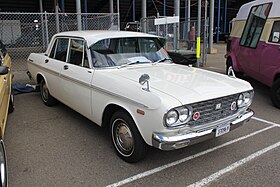 1967 Toyota Crown sedan (MS45, Australia) | |
| Overview | |
| Model code | S40 |
| Also called | Toyota Crown |
| Production |
|
| Assembly |
|
| Body and chassis | |
| Body style |
|
| Layout | Front-engine, rear-wheel-drive |
| Related | Toyopet Masterline |
| Powertrain | |
| Engine | |
| Transmission |
|
| Dimensions | |
| Wheelbase | 2,690 mm (105.9 in) |
| Length |
|
| Width |
|
| Height | 1,460 mm (57.5 in) |
| Curb weight |
|
Due to the introduction of the Corona, the dramatically restyled and enlarged Series S40 was launched in 1962, and saw the introduction of the Custom model. According to the Japanese Wikipedia article for the Crown, the styling was said to be influenced by the recently introduced Ford Falcon in 1960. The front grill approach has a similar appearance to the 1960 Imperial Crown (Chrysler), which speaks to Toyota's aspirations that the Crown be a large, comfortable sedan. The station wagon body style carried over from the previous generation Masterline, but with more attention to the luxurious approach used on the Crown.
Headlights were integrated within the boundaries of the greatly enlarged grill, providing a clean, modern appearance. A 2-speed automatic transmission was introduced, called Toyoglide, with a column shift. A bigger and better car than the previous S30 series, it initially had four-cylinder R-series engines before the addition of the "M" six-cylinder engine in 1965. Deluxe and Super Deluxe models were available with added features. The ladder frame chassis of the previous generation was replaced with an X-frame to achieve a lower centre of gravity.[28] The sedan and wagon were known simply as the Crown while the commercial vehicles (coupe utility, double cab coupe utility (pick ups), and van) were known as the Masterline. There was also a limited run of the sedan known as the Toyota Crown S (MS41S) which featured twin SU style carburettors on the 2.0L M in-line-six engine, sportier camshaft, sports instrumentation, sports suspension, four-speed floor shift, bucket seats, 14 inch wheels, disc brakes on the front and larger drum brakes in the rear.[16]
This Crown became the first Toyota to be exported to Europe, after the head of Denmark's Erla Auto Import A/S saw it at the Tokyo Motor Show. They brought in 190 of these subsequent to a May 1963 agreement.[29] In Canada, it was introduced in November 1964 as one of the first Toyota models available in the country alongside the UP10 Publica.[5] In the US, the MS41L sedan was available in the US for US$2,305 (equivalent to about $23,217 in 2023) PoE while the MS46LG station wagon was available for US$2,525 (equivalent to about $25,433 in 2023) PoE. Some optional features include an automatic transmission for US$160 (equivalent to about $1,612 in 2023) and a radio for US$60 (equivalent to about $604 in 2023).
A two-door Crown Convertible was displayed at the 1963 Tokyo Motor Show, based on the Crown 1900 sedan. It was not put into production.
This Crown generation was the first to be assembled in Australia, from CKD kits, by AMI in Port Melbourne, with significant local content. AMI, which assembled numerous brands including Triumph and, for a short time, Mercedes-Benz, was to become the basis of Toyota's current Australian manufacturing operation.
Crown Eight (G10)
| Toyota Crown Eight | |
|---|---|
 | |
| Overview | |
| Model code |
|
| Production | April 1964 – July 1967 |
| Assembly | Japan: Yokosuka (Kanto Auto Works)[26] |
| Body and chassis | |
| Body style | 4-door sedan |
| Layout | Front-engine, rear-wheel-drive |
| Powertrain | |
| Engine | 2.6L (2599cc) V V8 |
| Transmission | 3-speed automatic column |
| Dimensions | |
| Wheelbase | 2,750 mm (108 in) |
| Length | 4,720 mm (186 in) |
| Width | 1,845 mm (72.6 in) |
| Height | 1,460 mm (57 in) |
| Curb weight | 1,375 kg (3,031 lb) |
| Chronology | |
| Successor | Toyota Century |
The longer, wider and more upmarket Crown Eight was introduced in 1964 for the Japanese market, powered by a 2.6 L V8 engine. However, it had a different model designation, G10 (VG10 when fitted by 2.6 L V engine). The car was first introduced at the 1963 Tokyo Motor Show and introduced for sale on April 20, 1964, nine days before Emperor Showa's birthday and the beginning of Golden Week in Japan.
The Crown Eight was developed and assembled by Toyota's subcontracting company Kanto Auto Works. Toyota delegated the production because the Crown Eight had many different components compared to the Crown, which could have hindered mass-production operations at the Motomachi plant as the Crown Eight's production volume was approximately 1,000 cars per year.[26]
The Crown Eight was designed primarily to replace full-sized American automobiles that were commonly used by major corporations. The Crown Eight represents the first Japanese mass-produced vehicle with an 8-cylinder engine. The main rivals at the time were the Prince Gloria Super, Mitsubishi Debonair, and Nissan Cedric Special, all equipped with a six-cylinder engine. It was the first Crown to exceed vehicle size classification regulations in length, width and engine displacement capacity. The width at 1,845 mm (72.6 in) compares to the Century at 1,890 mm (74 in), and as such no Crown before or since, including the Crown Majesta, has matched the width dimension of the Crown Eight until the year 2008 for Crown and 2009 for Majesta.
The Crown Eight was considered as a possible submission for use by the Japanese Imperial Household Agency as a car to be used by senior members of the Imperial House of Japan, but it lost out to the Nissan Prince Royal. The Crown Eight was replaced in 1967 by the first Century with the model code VG20. Approx 3,800 Crown Eights were produced. Some of the items that were exclusive to the Crown Eight were climate control, automatic headlamps, electrically powered windows, electric cruise control, a three-speed "Toyoglide" automatic transmission, and electromagnetic door latches, which were also installed on the Crown Eight successor, the Century.[30]
Toyopet Crown – Third generation (S50; 1967)
| Toyopet Crown – Third generation | |
|---|---|
 Toyota Crown Super Deluxe (S50, Japan) | |
| Overview | |
| Model code | S50 |
| Also called | Toyota Crown |
| Production | 1967–1971 |
| Assembly | |
| Body and chassis | |
| Body style |
|
| Layout | Front-engine, rear-wheel-drive |
| Powertrain | |
| Engine | |
| Transmission |
|
| Dimensions | |
| Wheelbase | 2,690 mm (105.9 in)[32] |
| Length |
|
| Width | 1,690 mm (66.5 in) |
| Height |
|
| Curb weight | 1,305–1,410 kg (2,877–3,109 lb) |
Launched in 1967, the mechanicals were much the same as the previous generation, but additional equipment was included. The X-frame chassis of the S40 series was now dropped in favour of a perimeter frame that improved collision protection for passengers; this chassis design would remain in use until 1999 when the S130-series wagons were superseded by the unibody S170-series Estates.[28] Higher specification models used the 2.0-liter M engine or the 2.3-liter 2M engine shared with the Toyota 2000GT sports coupe. A premium level Super Saloon joined the Super Deluxe model, and was available with the 2M engine including twin carburettors, electric windows, rear seat radio controls, air conditioning and luxury fabric on the seating including the Crown logo embossed into the vinyl. Lower specified models were equipped with the R-series four-cylinder engines. Crown vehicles meant for commercial use had received the Masterline nameplate until the introduction of this generation; they were now badged "Crown" as well. However, this generation was the last to be offered in an entire line of commercials - from the next generation on, the only commercial-use model available was the Crown Van, whose bodywork was also used for the Wagon models. Crown Double-Cab pickups were produced by the former Central Motor Co., Ltd. until December 1970.[18]
When the 1967 S50 series Crown was introduced to Japan, television commercials used Japanese actor Satoshi Yamamura, who among his many roles on stage, movie, and television, portrayed Fleet Admiral Isoroku Yamamoto in the 1970s movie Tora! Tora! Tora! Yamamura would serve as the Crown spokesman for 16 years, introducing subsequent new generations of Crown products until 1983.[citation needed]
The Crown range now included the four-door station wagon, pick-up (rare), double cab pick-up (very rare) and the new two-door hardtop "personal luxury car". In September 1968 the option of power steering was added.[33] In 1969 the Crown received a facelift for the headlight, grill and trim arrangement. The Crown S used the two-liter 'six', but due to sportier tuning it produced more power than the larger 2M, 125 PS (92 kW) at 5,800 rpm versus 115 PS (85 kW) at 5,200 rpm.[32] The commercial versions were fitted with the six-cylinder "M" engine (M-C) produce 105 PS (77 kW), while the four-cylinder 5R had to make do with 93 PS (68 kW).[34] This generation was the only one to use a double-hinged tailgate, as the next generation converted to an overhead-lifting hatchback door.
Crowns that were equipped with the 2,253 cc 2M engine were no longer classified as compact cars under Japanese vehicle size classification regulations, even though the length and width were still in compliance. Toyota offered the larger engine so that buyers who were traditionally served by the Crown could now choose the all-new Corona Mark II in 1968. This allowed Toyota to reposition the Crown as the top level privately available luxury sedan, with much nicer interior treatments, more spacious accommodations. This was the last generation for the pick-up versions of the Crown, as load carrying was ceded to the new Toyota Hilux in February 1971.
Australian market models were assembled in Australia by Australian Motor Industries.[35] The two-door ute was also assembled in Australia, but not the coupé model.[31] This generation was imported fully assembled into New Zealand from 1968 to 1971.[citation needed]
This generation was still sold in the United States; 1970 was the most successful year for the nameplate in the US with 6,528 being sold.[2]
Notable features on the Crown Wagon were:
- 7- or 8-passenger seating (two on front buckets or three on a bench seat, three on a rear bench seat, and two on a fold up cargo seat),
- a powered rear window,
- a side-swing tailgate.
Fourth generation (S60/S70; 1971)
| Fourth generation | |
|---|---|
 1973–1975 Toyota Crown SE sedan (MS65, Australia) | |
| Overview | |
| Model code |
|
| Production | February 1971–September 1974[36] |
| Assembly |
|
| Body and chassis | |
| Body style |
|
| Layout | Front-engine, rear-wheel-drive |
| Powertrain | |
| Engine | |
| Transmission | |
| Dimensions | |
| Wheelbase | 2,690 mm (105.9 in) |
| Length | 4,680 mm (184.3 in) |
| Width | 1,690 mm (66.5 in) |
| Height | 1,420 mm (55.9 in) |
| Curb weight | 1,290–1,360 kg (2,844–2,998 lb) |
Launched in February 1971 for the Japanese Domestic Market, the fourth generation Crown was available in ascending trim levels, including Deluxe, Super Deluxe and Super Saloon. Another trim, Royal Saloon, introduced with the Crown's 1973 facelift, added luxury features from the Century limousine. The first two model years of the fourth generation Crown were marketed in North America; subsequently replaced by the Corona Mark II.
the 4M 2600 engine was introduced, with the 2.0-liter 5R inline-four engine and the 2.0-liter M six-cylinder engine also available. As for the previous generation, the M-C engine (in Japanese specifications) has 105 PS (77 kW; 104 bhp), while the 5R's output increased somewhat to 98 PS (72 kW; 97 bhp).[38][39] In some markets the previous 2.3-liter "2M" six remained available, in sedan or "utility wagon" forms.
The Utility Wagon was a body style between commercial and passenger car, and carried chassis codes MS67V until the early 1973 facelift when it was replaced by the MS68V with the 2.6 engine.[40]
While previous generations of the Crown had been marketed under the Toyopet brand, the fourth-generation model was the first version to be officially marketed worldwide as the Toyota Crown.[41]
The Sedan and Wagon (Custom) were coded RS60/MS60/MS64/MS65 and MS62/MS63, while the Van was coded MS66V with the two liter "six". The Hardtop Coupé is MS70 (2.0-liter), or MS75 (2.6-liter). The Japanese market Crown Custom (Wagon) was classified as a seven-seater.[39] This generation was the first Crown marketed as a Toyota in Japan, as previous models were marketed as Toyopets. Also, in Japan, this model was known as the "whale" or "kujira" Crown.
In 1973, Japanese television commercials introduced Japanese actress Sayuri Yoshinaga as a co-spokeswoman, joining Satoshi Yamamura, and together they appeared in commercials until 1983.[citation needed]
Crown's for the Japanese Domestic Market Hardtop featured rectangular halogen headlights, and export models featured twin round headlights. All models featured flush bumpers, marketed by Toyota as "spindle-shaped."[42][38]
The trunk could be opened remotely by turning the ignition key to the far left, and a floor-mounted button engaged the radio's signal seeking feature. A separate signal seeking feature was installed for rear seat passengers, installed behind the front seat facing the rear seat compartment. The 60-series Crown received a facelift in January 1973.[40]
Australian models were assembled in Australia by AMI.[43] It was available in New Zealand fully imported from 1971 to 1973, with local assembly beginning at Steels Motor Assemblies, who also built the Corona, not long before the mid-life facelift, improving availability. Steels subsequently became Toyota NZ's Christchurch CKD assembly plant.[citation needed]
-
2600 Super Saloon Coupe (pre-facelift; UK)
-
2600 Super Saloon Coupe (pre-facelift; US)
-
Super Saloon sedan (Japan)
-
SE Sedan (facelift; Australia)
-
2600 Estate (facelift; UK)
-
2600 Estate interior
Fifth generation (S80/S90/S100; 1974)
| Fifth generation | |
|---|---|
 1978 Toyota Crown 2600 Deluxe (New Zealand) | |
| Overview | |
| Model code |
|
| Production | October 1974–August 1979[36] |
| Body and chassis | |
| Body style |
|
| Layout | Front-engine, rear-wheel-drive |
| Powertrain | |
| Engine | |
| Transmission |
|
| Dimensions | |
| Wheelbase | 2,690 mm (105.9 in) |
| Length |
|
| Width | 1,690 mm (66.5 in) |
| Height | 1,440 mm (56.7 in) |
| Curb weight | 1,470–1,520 kg (3,241–3,351 lb) |
Launched in 1974 in Japan, export began from 1975. It was offered as four-door sedan, two-door hardtop coupe, four-door hardtop sedan, wagon, and van. Engines are 2.0- and 2.6-liter gasoline. The 2.2-liter diesel was introduced in October 1977.[44] Trim levels are Standard, Deluxe, Super Saloon, and Royal Saloon.

The Royal Saloon came in a longer body length, coupled with the 2.6L engine while lower trim levels were in the shorter body style and 2.0 L engines. Export models used the same body whether the two-liter 5R four-cylinder or the 2.6-liter 4M inline-six. In Europe, these models claimed 87 and 112 PS (64 and 82 kW) respectively.[45]
Minor change was given in 1978. This version of the Crown saw the introduction of disc brakes at both the front and rear axles with anti-lock brakes, speed sensitive power steering, and a 4-speed automatic transmission with overdrive. Originally, sedans and wagons had S80-series chassis numbers, while the two- and four-door hardtops received the S90-series chassis numbers. After 1976 and concurrent with the introduction of new stricter emissions regulations, all Japanese market Crowns used S100-series chassis numbers. Export models continued to use the previous codes.[46]
Initially available with the "old style" 4M engine with rounded valve cover, later models switched to the new 4M engine with rectangular valve cover. This generation also saw the introduction of fuel injection on both the 2.6-liter 4M and the 2.0-liter M engines, coupled with Toyota's TTC-C technology, adding a catalytic converter to the exhaust system. The emissions controlling technology badge helped identify which vehicles had reduced emissions tax liability. Select models also were available with four-wheel disc brakes and twin piston calipers on the front brakes. The models installed with the diesel engine was exclusive to Toyota Diesel Store locations.
The Hardtop Sedan model has a front chrome grill and square headlights, but was no longer considered a true hardtop, due to the inclusion of a "B" pillar. The styling differences between the hardtop and sedan four-door models was that the side windows on the hardtop were frameless, and the rear window was sloped more than the formal appearing sedan. This series Crown in the Royal Saloon trim package exceeded length regulations of 4.7 m set forth by Japanese regulations by 65 mm, but Toyota continued to offer a 2.0 L engine in a shorter vehicle for buyers who were looking for better fuel economy over the larger six-cylinder engines, and reduced road tax liability.
New Zealand models were assembled in New Zealand but on an SKD basis - which meant it had more Japanese content (such as glass) than earlier CKD versions. It was the last Crown built in New Zealand and was replaced in 1979 by the Cressida (Mark II), which was available with a four-cylinder engine. The oil crises of 1973/4 and 1979/80 had led the government to impose a 60 percent sales tax on larger engines, and the Crown could no longer be priced to suit its market.[citation needed] This generation Crown was locally assembled in Australia[47] (except for the imported "Super Saloon" trim), and only available with the largest 2.6-liter six-cylinder engine. It was never a strong seller in Australia, offering less performance and roadholding than the domestic competitors from Ford and Holden.[48]
-
S80 series Crown Sedan
Zdroj:https://en.wikipedia.org?pojem=Toyota_Crown
Text je dostupný za podmienok Creative Commons Attribution/Share-Alike License 3.0 Unported; prípadne za ďalších podmienok. Podrobnejšie informácie nájdete na stránke Podmienky použitia.
Antropológia
Aplikované vedy
Bibliometria
Dejiny vedy
Encyklopédie
Filozofia vedy
Forenzné vedy
Humanitné vedy
Knižničná veda
Kryogenika
Kryptológia
Kulturológia
Literárna veda
Medzidisciplinárne oblasti
Metódy kvantitatívnej analýzy
Metavedy
Metodika
Text je dostupný za podmienok Creative
Commons Attribution/Share-Alike License 3.0 Unported; prípadne za ďalších
podmienok.
Podrobnejšie informácie nájdete na stránke Podmienky
použitia.
www.astronomia.sk | www.biologia.sk | www.botanika.sk | www.dejiny.sk | www.economy.sk | www.elektrotechnika.sk | www.estetika.sk | www.farmakologia.sk | www.filozofia.sk | Fyzika | www.futurologia.sk | www.genetika.sk | www.chemia.sk | www.lingvistika.sk | www.politologia.sk | www.psychologia.sk | www.sexuologia.sk | www.sociologia.sk | www.veda.sk I www.zoologia.sk

